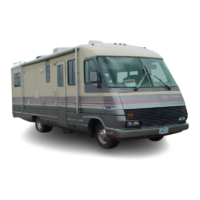36
Discovery, Discovery LXE, Pace Arrow, and Pace Arrow LXEt
Disabling Brakes:
Place wheel chocks rmly
against the wheel before
performing this procedure.
WARNING:
Failure to securely chock
the wheels can result in
the motorhome rolling
when the spring brakes are
released. Severe injury or
death can occur.
Open the dust cap from the
center of brake chamber on
the drive axle.
Remove the caging tool
from its holder and insert
the tool into hole. Turn
clockwise to engage.
Assemble nut and washer
onto caging tool. Use a
wrench to tighten the nut.
This will compress the
internal spring and release
the brake.
Repeat procedure for the
other side.
Enabling Brakes:
After towing, or when
air pressure is available,
remove nut, washer and
caging tool. Install the
caging tool to its storage
location and close the dust
cap.
Repeat procedure for the
other side.
TIRES
Maintaining proper tire ination
pressure is important for proper
tire load carrying capacity and
wear. Improper pressure will lead
to abnormal wear and/or sudden
tire failure. Weigh the motorhome
fully loaded for travel to determine
proper tire ination pressure.
If one tire position on the axle
is heavier than the other side,
inate both sides according to the
heaviest side. This will provide
correct tire ination pressure
across the axle and provide
stability while cornering. To
obtain the maximum wear and best
service from tires, it is helpful to
understand their components and
functions.
Tire Components:
Tread: Provides traction
and cornering grip.
Belts: Stabilize and
strengthen the tread.
Sidewall: Protects the side
of the tire from road and
curb damage.
Body Ply: Provides tire
strength and exibility.
Bead: Assures an air-tight
t with the wheel.
Inner Liner: Keeps air
inside the tire.
090438
090369
Brake Camber
090456
090368
Example of a
properly chocked
wheel.

